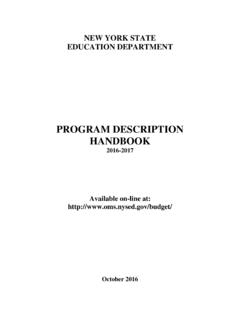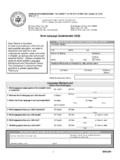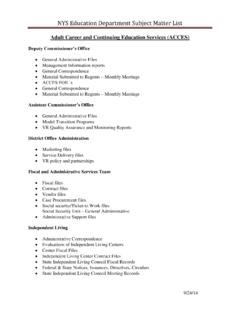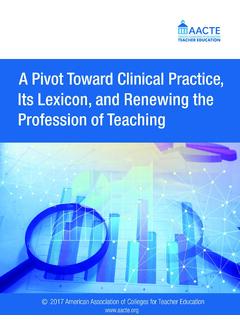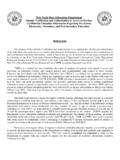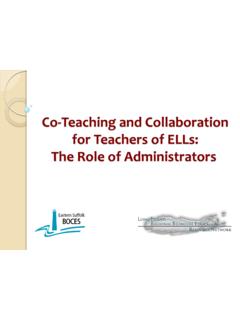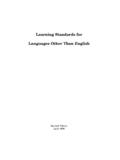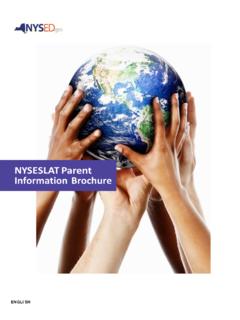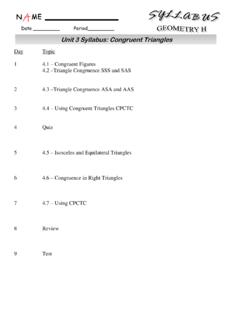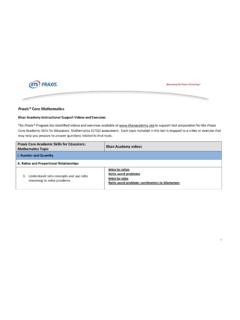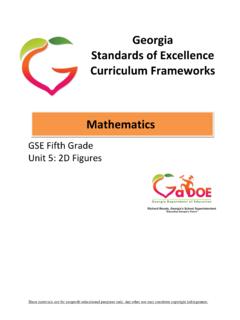Transcription of New York State Next Generation Mathematics Learning ...
1 NYSED geometry Draft: Specific modeling domains, clusters and standards are indicated by a star symbol . New York State next Generation Mathematics Learning standards geometry Crosswalk geometry congruence ( ) Cluster NYS P-12 CCLS NYS next Generation Learning Standard Experiment with transformations in the plane. Know precise definitions of angle, circle, perpendicular line, parallel line, and line segment, based on the undefined notions of point, line, distance along a line, and distance around a circular arc. Know precise definitions of angle, circle, perpendicular lines, parallel lines, and line segment, based on the undefined notions of point, line, distance along a line, and distance around a circular arc as these exist within a plane.
2 Represent transformations in the plane using, , transparencies and geometry software; describe transformations as functions that take points in the plane as inputs and give other points as outputs. Compare transformations that preserve distance and angle to those that do not ( , translation versus horizontal stretch). Represent transformations as geometric functions that take points in the plane as inputs and give points as outputs. Compare transformations that preserve distance and angle measure to those that do not. Note: Instructional strategies may include drawing tools, graph paper, transparencies and software programs. Given a rectangle, parallelogram, trapezoid, or regular polygon, describe the rotations and reflections that carry it onto itself. Note: Trapezoid is defined as a quadrilateral with at least one pair of parallel sides.
3 Given a regular or irregular polygon, describe the rotations and reflections (symmetries) that map the polygon onto itself. Note: The inclusive definition of a trapezoid will be utilized, which defines a trapezoid as A quadrilateral with at least one pair of parallel sides. NYSED geometry Draft: Specific modeling domains, clusters and standards are indicated by a star symbol . New York State next Generation Mathematics Learning standards geometry Crosswalk geometry congruence ( ) Cluster NYS P-12 CCLS NYS next Generation Learning Standard Experiment with transformations in the plane. Develop definitions of rotations, reflections, and translations in terms of angles, circles, perpendicular lines, parallel lines, and line segments. Develop definitions of rotations, reflections, and translations in terms of points, angles, circles, perpendicular lines, parallel lines, and line segments.
4 Notes: Includes point reflections. A translation displaces every point in the plane by the same distance (in the same direction) and can be described using a vector. A rotation requires knowing the center (point) and the measure/direction of the angle of rotation. A line reflection requires a line and the knowledge of perpendicular bisectors. Given a geometric figure and a rotation, reflection, or translation, draw the transformed figure using, , graph paper, tracing paper, or geometry software. Specify a sequence of transformations that will carry a given figure onto another. Given a geometric figure and a rotation, reflection, or translation, draw the transformed figure. Specify a sequence of transformations that will carry a given figure onto another.
5 Notes: Instructional strategies may include graph paper, tracing paper, and geometry software. Includes point reflections. A translation displaces every point in the plane by the same distance (in the same direction) and can be described using a vector. A rotation requires knowing the center (point) and the measure/direction of the angle of rotation. A line reflection requires a line and the knowledge of perpendicular bisectors. Singular transformations that are equivalent to a sequence of transformations may be utilized, such as a glide reflection. However, glide reflections are not an expectation of the course. NYSED geometry Draft: Specific modeling domains, clusters and standards are indicated by a star symbol . New York State next Generation Mathematics Learning standards geometry Crosswalk geometry congruence ( ) Cluster NYS P-12 CCLS NYS next Generation Learning Standard Understand congruence in terms of rigid motions.
6 Use geometric descriptions of rigid motions to transform figures and to predict the effect of a given rigid motion on a given figure; given two figures, use the definition of congruence in terms of rigid motions to decide if they are congruent. Use geometric descriptions of rigid motions to transform figures and to predict the effect of a given rigid motion on a given figure. Given two figures, use the definition of congruence in terms of rigid motions to decide if they are congruent. Notes: A translation displaces every point in the plane by the same distance (in the same direction) and can be described using a vector. A rotation requires knowing the center (point) and the measure/direction of the angle of rotation. A line reflection requires a line and the knowledge of perpendicular bisectors.
7 Use the definition of congruence in terms of rigid motions to show that two triangles are congruent if and only if corresponding pairs of sides and corresponding pairs of angles are congruent. Use the definition of congruence in terms of rigid motions to show that two triangles are congruent if and only if corresponding pairs of sides and corresponding pairs of angles are congruent. Explain how the criteria for triangle congruence (ASA, SAS, and SSS) follow from the definition of congruence in terms of rigid motions. Explain how the criteria for triangle congruence (ASA, SAS, SSS, AAS and HL (Hypotenuse Leg)) follow from the definition of congruence in terms of rigid motions. NYSED geometry Draft: Specific modeling domains, clusters and standards are indicated by a star symbol.
8 New York State next Generation Mathematics Learning standards geometry Crosswalk geometry congruence ( ) Cluster NYS P-12 CCLS next Generation Learning Standard (2017) Prove geometric theorems. Prove theorems about lines and angles. Theorems include: vertical angles are congruent; when a transversal crosses parallel lines, alternate interior angles are congruent and corresponding angles are congruent; points on a perpendicular bisector of a line segment are exactly those equidistant from the segment s endpoints. Note: Theorems include but are not limited to the listed theorems. Example: theorems that involve complementary or supplementary angles. Prove and apply theorems about lines and angles. Note: Include multi-step proofs and algebraic problems built upon these concepts.
9 Examples of theorems include but are not limited to: Vertical angles are congruent. If two parallel lines are cut by a transversal, then the alternate interior angles are congruent. The points on a perpendicular bisector are equidistant from the endpoints of the line segment. Prove theorems about triangles. Theorems include: measures of interior angles of a triangle sum to 180 ; base angles of isosceles triangles are congruent; the segment joining midpoints of two sides of a triangle is parallel to the third side and half the length; the medians of a triangle meet at a point. Note: Theorems include but are not limited to the listed theorems. Example: an exterior angle of a triangle is equal to the sum of the two non-adjacent interior angles of the triangle. Prove and apply theorems about triangles. Note: Include multi-step proofs and algebraic problems built upon these concepts.
10 Examples of theorems include but are not limited to: Angle Relationships: The sum of the interior angles of a triangle is 180 degrees. The measure of an exterior angle of a triangle is equal to the sum of the two non-adjacent interior angles of the triangle. Side Relationships: The length of one side of a triangle is less than the sum of the lengths of the other two sides. In a triangle, the segment joining the midpoints of any two sides will be parallel to the third side and half its length. Isosceles Triangles Base angles of an isosceles triangle are congruent. NYSED geometry Draft: Specific modeling domains, clusters and standards are indicated by a star symbol . New York State next Generation Mathematics Learning standards geometry Crosswalk geometry congruence ( ) Cluster NYS P-12 CCLS next Generation Learning Standard (2017) Prove geometric theorems.
